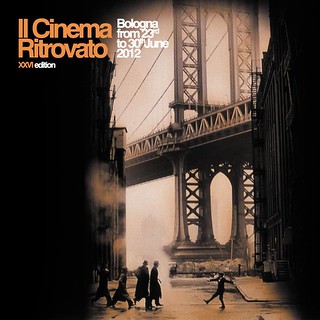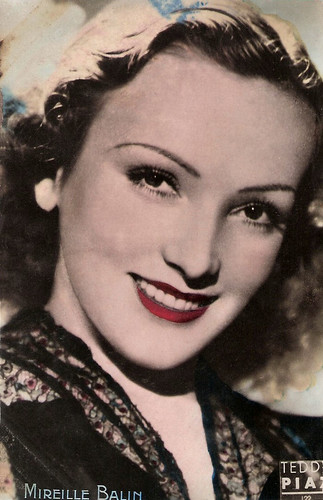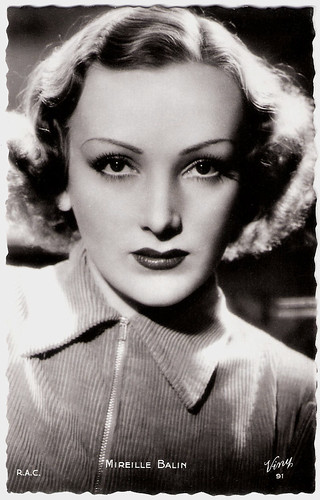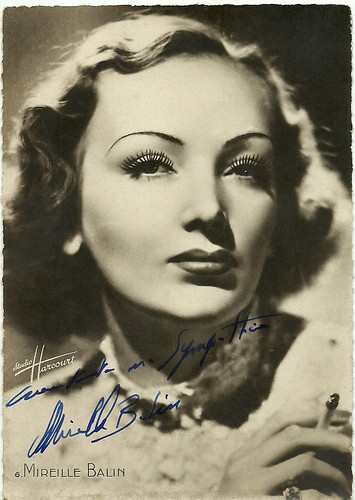
One of the tributes at this year's festival is for the least known among the great French filmmakers, Jean Grémillon. One of his masterpieces is Gueule d'amour (1937) starring the most beautiful woman of the French cinema of the 1930s, Mireille Balin (1909-1968). The glamorous actress is best known as the femme fatale who lured Jean Gabin into his downfall in Pépé le Moko (1936). After the war, her love affair with a Wehrmacht officer lead to the end of her career and Balin died poor and forgotten.

French postcard by Editions P.I., Paris, no. 108. Photo: Star.

French postcard by O.P., Paris, no. 122. Photo: Teddy Piaz.

French card by Massilia. Collection: Amit Benyovits.
A glamorous life
Mireille Balin was born Blanche Mireille Césarine Balin in Monte Carlo, Monaco in 1909. Her father was a journalist at the newspaper Tribune de Geneve, and her mother was Italian. Her father gave her a strict upbringing and sent her to a boarding school for girls in Marseille. She learned Italian, German, and English, practised horseriding and studied piano at the academy.
Then her parents moved to Paris, hoping to get out of their financial difficulties. Forced to make a living, she worked as a saleswoman, and then as a secretary for the couturier Jean Patou. She soon became his supermodel. Filmmaker Maurice Cammage discovered her in 1932 for the cinema and gave her a part, credited as Mireille Séverin, in Vive la classe!/Long live the class! (Maurice Cammage, 1932), a comedy with Fernandel.
Then she appeared in the French version of Don Quichotte (Georg Wilhelm Pabst, 1932). She was the niece of Cervantes' hero, played by the famous Russian opera singer Fyodor Chaliapin. This role launched her film career. In October 1933 she met Raymond Patenôtre, billionaire, politician, future minister and owner of newspapers. They began a passionate love affair.
Balin got a major role in Vive la compagnie/Long live the company (Claude Moulins, 1934), which was a nice success. Balin lived quite a glamorous life: the Opera, La Coupole, the Fouquet's, Maxim's. She had a love affair with Victor Younki, aka Young Perez, a young boxer from Tunisia, who was 'World Flyweight Champion' in 1931.
In 1933, she played opposite Pierre Brasseur in the comedy Le Sexe faible/The Weaker Sex (Robert Siodmak, 1933). Then she appeared in the French-German comedy Adieu les beaux jours/Goodbye beautiful days (André Beucler, Johannes Meyer, 1933) starring Brigitte Helm and Jean Gabin. She played her first lead role in On a trouvé une femme nue/We found a nude woman (Léo Joannon, 1934), in which Balin really appeared nude - only her back can be seen in the scene.
She made a first - and only - attempt at the theatre with Edouard Bourdet, but it was a failure. Next, she played a scorned woman in Marie des angoisses/Marie of the anxieties (Michel Bernheim, 1935), with Pierre Dux and Francoise Rosay, followed by a kept woman in Le Roman d'un spahi/The romance of a spahi (Michel Bernheim, 1935), based on a script written by Pierre Loti.

French postcard by Viny, no. 91. Photo: R.A.C.

French postcard by O.P., Paris, no. 16. Photo: Star.

French postcard by Editions P.I., Paris, no. 39. Photo: Teddy Piaz.
Timeless classic
In 1936, Mireille Balin had a brief affair with Jean Gabin. Director Julien Duvivier then assigned her to the role of Gaby Gould in his Pépé le Moko (1936). Her elegant beauty contrasted beautifully with the dark and narrow alleys of the Casbah of Algiers, carefully reconstructed in the studio by Duvivier. Classic is the end of the film. The gangster Pépé (Gabin) is arrested and handcuffed by the police but still manages to commit suicide with a knife. The tourist from Paris, Gaby desperately waits for him while her ship is leaving the port of Algiers. She tries to embrace the Casbah and the invisible Pépé with a last, desperate look.
Pépé Le Moko ia a masterpiece, and it made Mireille Balin a star. The film was later remade in Hollywood as Algiers (John Cromwell, 1938) starring Charles Boyer and Hedy Lamarr. According to IMDb, the producer of Algiers, Walter Wanger tried to have all copies of Pépé le Moko destroyed. Fortunately, he was not able to do so. James Travers at Films de France calls Pépé le Moko a ‘timeless classic’: “assuredly one of the darkest and most stylish French films of the 1930s - French film noir at its most vivid and intoxicating.”
Balin then played a vamp in Gueule d'amour/Lady Killer (Jean Gremillon, 1937), again opposite Gabin. James Travers describes her role thus: “the deliciously vile femme fatale Madeleine, superbly portrayed by Mireille Balin, who immediately strikes us as the worst that womankind has to offer.“ Next followed a role in Naples au baiser de feu/Kiss of Fire (Augusto Genina, 1937) with Tino Rossi, Michel Simon and Viviane Romance. This was the third huge box office success in a row.
At the end of 1937, Balin signed a contract with MGM and moved to the United States. But, in conflict with American producers, she took the boat back to France with her new boyfriend, Tino Rossi. In Paris, she made Menaces/Threats (Edmond T. Gréville, 1939) opposite John Loder and Erich Von Stroheim. Balin played a saleswoman in a fashion house, engaged to a British pilot but loved by a wistful artist. The film was banned and burned during the occupation of France but was restored and distributed after the liberation.
Her next film, the exotic melodrama Macao (Jean Delanno, 1940y) was also banned by the Nazis in June 1940, due to the presence of Erich Von Stroheim, Austrian by origin and fervent anti-Nazi. The film was two years later released, with a new title, L'Enfer du jeu/Gambling Hell (1942). The scenes with Von Stroheim were replaced by new scenes, shot with Pierre Renoir.

French postcard by Editions et Publicationscinématographiques, no. 140. Photo: ACE.

German postcard by Ross-Verlag, no. A 3419/1. Photo: Ufa.

French postcard by SERP, Paris, no. 6. Photo: Studio Harcourt. Collection: Didier Hanson.
A young Viennese wehrmacht officer
In 1940, Mireille Balin filmed in the Cinecittà studio in Rome L'assedio dell'Alcazar/The Siege of the Alcazar (Augusto Genina, 1940) with Fosco Giachetti. This staunchly pro-Franco film would bring her in serious trouble after the liberation. During the occupation of France, she also participated in Nazi charity galas for prisoners of war and was regularly seen at parties at the German embassy in Paris.
In 1941, her relationship with Tino Rossi had ended, and at an embassy party, she met Birl Desbok, a young Viennese Wehrmacht officer. They became lovers. She made a few more films, including L'assassin a peur la nuit/The murderer is afraid at night (Jean Delannoy, 1942) with Jean Chevrier, Dernier Atout/Last Trump (Jacques Becker, 1942) and Haut le vent/The High Wind (Jacques de Baroncelli, 1942) with Charles Vanel.
In the summer of 1944, as Paris was about to be liberated, she and Desbok fled Paris and tried to reach the Italian border but on 28 September 1944, they were arrested by the FFI (French resistance fighters) in Beausoleil near Nice. According to Wikipedia, she was beaten and raped, and imprisoned in Nice. What happened to Birl Desbok is unknown. Wikipedia suggests that he was probably executed during his arrest.
In court, Balin was reproached for her affair, her participation in Les Cadets de l'Alcazar/The Cadets of Alcazar and her appearances at the artistic galas of the German Embassy in Paris. She was released in January 1945, but her health, her career and her life were broken. She was forbidden to work for a year but once this restriction was lifted, she went back to the studios to appear in La dernière chevauchée/The Last Ride (Léon Mathot, 1947) with Jacques Dumesnil. But the public had turned away from her and it would be her last film.
She went into oblivion at the Côte d'Azur. Ten years later, she returned to Paris, completely broke and physically ruined by typhoid, meningitis, a stroke and alcoholism. La Roue tourne (The Wheel turns), an association founded by Paul Azaïs and his companion Janalla Jarnach to help artists in need, supported her during her final years. Forgotten, Mireille Balin died in 1968 at the Beaujon Hospital in Clichy. She was only 59. La Roue Tourne took care that she was buried at the cemetery of Saint-Ouen. It is said that on her coffin a small teddy bear was placed, donated by Tino Rossi. In 1973 her vault was shared by Jean Tissier, another forgotten actor. In 1989, the biography 'Mireille Balin ou la beauté foudroyée' by Daniel Arsand was published.

French postcard by Viny, no. 4. Photo: R.A.C. Collection: Didier Hanson.

Italian postcard by Rizzoli & C., Milano, 1940. Photo: ACE.

French postcard by Editions O.P., Paris, no. 23. Photo: Teddy Piaz, Paris.
Trailer Pépé le Moko (1936). Source: Tototrailers (YouTube).
Sources: James Travers (French Films), Christophe Greseque (IMDb), Mireille Balin Femme Fatale (now defunct), Wikipedia (French), and IMDb.
This post was last updated on 1 May 2023.
2 comments:
This is a lovely blog thta shows 2 things I like too much: postcards and Cinema. Congratulations!
Please take a look at mine blog too: http://marklaropostcards.blogspot.pt/
Hi Marklaro,
Thanks for your kind comment. I liked your blog too and added it to my links of postcard blogs. Keep up the good work and greetings from Amsterdam!
Bob
Post a Comment